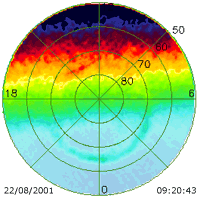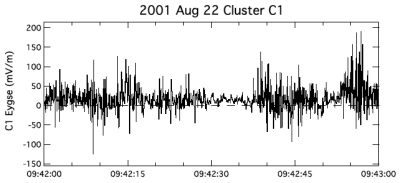Cluster probes generalized Ohm's law in space
9 November 2007
For the first time, a new element of the generalized Ohm's law has been evaluated in space thanks to data collected by the four satellites of the ESA/NASA Cluster mission. This fundamental law of Physics describes in detail the coupling between charged particles and the magnetic field. Its evaluation is necessary to fully understand explosive phenomena in space such as solar flares or magnetic substorms. Published 28 April 2007 in the Journal of Geophysical Research, a study of the newly measured element of the generalized Ohm's law provides a surprising outcome.The Sun continuously expels a fast flow of charged particles or plasma across the Solar System, the solar wind. This solar wind also carries the Sun's magnetic field into interplanetary space, where plasma and magnetic field tend to behave as if frozen together. The plasma particles lend magnetic field lines more substance by gyrating around them. Similarly, when plasma particles move en masse, the magnetic field lines behave as if they move with the particles. This tight coupling is what space physicists call the frozen-in condition.
 |
|
Animation 1. Sequence of auroral activity during a magnetic substorm on 22 August 2001, obtained with the FUV, Wide-field Imaging Camera (WIC) on board NASA's IMAGE spacecraft. |
If this condition were upheld under all circumstances, explosions on the Sun known as solar flares could not exist and the solar wind would never be able to penetrate the Earth's magnetic shield. But experimental evidence obtained in space has shown that these phenomena do occur and therefore the frozen-in condition is not always upheld. "Any violation of this condition is connected with a transfer of energy, a key topic in space plasma research," says Dr. Tony Lui, scientist at the Johns Hopkins University Applied Physics Laboratory, Maryland, USA.
The electric field is a key physical quantity to study in order to understand how the frozen-in condition breaks down. Two examples of processes where the condition breaks down and energy transfer occurs are
- Magnetic reconnection
At the heart of an explosive physical process known as magnetic reconnection the electric field controls the acceleration of particles. In this case, energy stored in the magnetic field is transferred to the particles using the electric field as if magnetic field lines were (magnetic) slingshots. - Current disruption
Magnetic field energy is tied to an electric current, which is a result of an organized motion of ions relative to electrons. Any process that decreases this organized motion will transform the associated magnetic field energy to other forms, such as heating of the particles and generation of waves. A highly fluctuating electric field can randomly accelerate the charged particles, such that the relative motion between ions and electrons decreases, a phenomenon known as current disruption.
Generalized Ohm's law - theory and observations
Space scientists detail the behaviour of the electric field using the generalised Ohm's law which decomposes the electric field, E, into the sum of five terms. When the frozen-in condition holds, for example in the solar wind, four of these terms are negligible, as has been verified experimentally in space. But when the frozen-in condition does not hold, all of the four terms need to be evaluated.
However, one of the four terms, resistivity, has never been fully probed in space so far and is generally neglected by space scientists. The term is associated with either collisional particle interactions or with anomalous resistivity, which arises from electric and magnetic field fluctuations associated with plasma turbulence. Recent theoretical advances published in February 2006 by Yoon and Lui (University of Maryland, USA) enable this anomalous term to be evaluated straightforwardly using standard scientific data measured in space.
On 22 August 2001, the four satellites of the Cluster mission were flying on the nightside of the Earth, in the magnetotail, roughly 120 000 km away from the Earth. There, for a couple of minutes (Image 1), two of the four satellites detected the breakdown of the frozen-in condition during a magnetospheric substorm (Animation 1).
"Evaluation of the terms in the generalized Ohm's law, using data collected by the Cluster satellites on 22 August 2001, indicates that the anomalous resistivity contribution arising from field fluctuations is the most significant one. This result demonstrates for the first time from observations that anomalous resistivity can play a substantial role in the breakdown of the frozen-in condition in the magnetotail during substorm expansions," says Tony Lui, lead author of this result, published 28 April 2007 in the Journal of Geophysical Research.
The spatial extent of the breakdown for the frozen-in condition has been estimated thanks to these simultaneous observations by two Cluster satellites more than 1000 km apart. Furthermore, the observed breakdown region did not have the specific magnetic field geometry envisioned in magnetic reconnection.
Magnetic substorms are a hot topic of research for space scientists, with an active on-going debate concerning its onset. Substorms cause colourful aurorae and can disturb the reception of GPS signals used for navigation.
"Cluster, the first scientific space mission composed of four satellites flying in constellation, enables us to probe deep down into the physics of explosive phenomena in space such as substorms for the first time. The work achieved by Tony Lui and his colleagues opens a new way of studying substorms," says Philippe Escoubet, Cluster and Double Star project scientist at the European Space Agency.
Lui, A. T. Y., Y. Zheng, H. Rème, M. W. Dunlop, G. Gustafsson, and C. J. Owen (2007), Breakdown of the frozen-in condition in the Earth's magnetotail, J. Geophys. Res., 112, A04215, doi:10.1029/2006JA012000.
Related articles
Yoon, P. H., and A. T. Y. Lui (2006), Quasi-linear theory of anomalous resistivity, J. Geophys. Res., 111, A02203, doi:10.1029/2005JA011482
Paschmann, G., Breaking through the lines, Nature, 439, p.144 (2006), doi:10.1038/439144a
Contact
Main author
Tony Lui, JHU/APL, 11100 Johns Hopkins Rd, 20723 Laurel, MD 20723-6099, USA
E-mail: tony.lui jhuapl.edu
jhuapl.edu
Phone: +1 240 228 55 98
Web story author and co-editor
Arnaud Masson, Science Directorate, ESA, The Netherlands
E-mail: Arnaud.Masson esa.int
esa.int
Phone: +31-71-565-5634
Web story editors
Philippe Escoubet, Science Directorate, ESA, The Netherlands
E-mail: Philippe.Escoubet esa.int
esa.int
Phone: +31-71-565-4564
Matt Taylor, Science Directorate, ESA, The Netherlands
E-mail: Matthew.Taylor esa.int
esa.int
Phone: +31-71-565-8009


